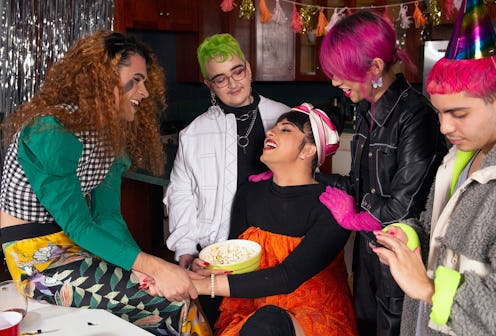Life
A Linguist Explains Why You Haven’t Heard Of Bisexual Slang

Could you define switch-hitting? Bicon? Or tomcat? Outside of the LGBTQ community, these terms aren't exactly common knowledge. But bisexual slang does exist, even though you might not be as familiar with it as you would gay or lesbian terminology.
As linguist and author of Wordslut: A Feminist Guide to Taking Back the English Language, Amanda Montell, tells Bustle, the LGBTQ community is "famously and historically inventive," and comes up with new words all the time to describe their identities and experiences. And much of that has made its way into mainstream culture. You'd be hard-pressed to find a young person who hasn't thrown out a "yas" or "werk" at least once, and even your grandmother probably knows the difference between butch and femme lesbians.
A "bicon" is a "bi icon," "switch-hitting" is a term borrowed from baseball to describe a person who is interested in both women and men, and "doe" is used to describe a femme bisexual woman, Montell says. There's also "crow," used to describe a masculine nonbinary person, and "tomcat," which refers to androgynous bisexual women. The list of bi slang goes on from there, but it all remains a bit more mysterious than a "yas" or a "werk".
And there are quite a few reasons for that. "As bi identity is still considered a taboo and goes unvalidated in many spaces, we don't seem to have the cultural or scholarly permission to move forward with studying it as a legitimate linguistic community," Montell tells Bustle.
This goes back to the problem of bisexual erasure. According to most research, bisexual people actually make up the majority of the LGBTQ community. But unfortunately, their sexual preference is frequently dismissed or ignored by straight and queer people alike. As Montell mentioned, little academic research focuses on bisexuality as anything more than an afterthought, and it's similarly erased in personal relationships.
All too often, bisexual people are told that they're "too gay" to be part of the straight community, and "too straight" to be LGBTQ. A bisexual man dating a woman, for example, may be told he is effectively straight, as if his current relationship magically turns off his attraction to men. Not to mention, many people assume that bisexual women don't want to admit to being lesbians, or that they're actually straight but claiming to be bisexual to titillate men.
One slang term within the community, "gay after three," even suggests some bisexuals are only bi after having three drinks, further implying bisexuality isn't "real," or is only a passing (or drunken) fancy. As you can probably guess, this constant invalidation has consequences. According to the Human Rights Campaign, bisexual people report depression at double the rates of heterosexual adults. And are also more likely to engage in binge drinking, self-harming behaviors, and suicidal thoughts than heterosexuals, lesbians, or gay men.
According to GLAAD, bisexual erasure also plays a critical role in reducing access to the resources and support opportunities bisexually oriented people so desperately need, which is a shame since bisexuals have a higher rate of STI diagnoses, as well as higher rates of cancer risk factors, and heart disease than heterosexuals. It's why many members of the community are creating awareness of public policy that benefits bisexuals, including launching bisexuality-related social media campaigns, and advocating for fair treatment in the media — among other things.
"LGBTQ+allies (and that includes those within the community who don't identify as bi) must continue to listen to bi folks, affirm bisexuality as a valid thing, and dismantle biphobia," Montell says. "The more bicons we see on TV, social media, and in our everyday lives, the more opportunities we'll have to learn more about (and accept) bi language and bisexuality at large."
Expert:
Amanda Montell, author and linguist
This article was originally published on